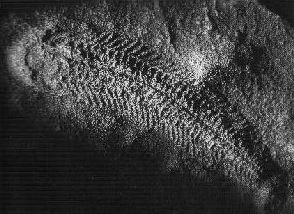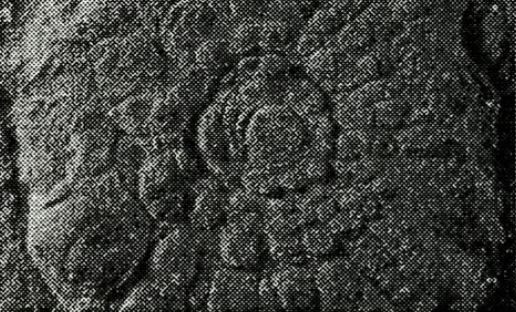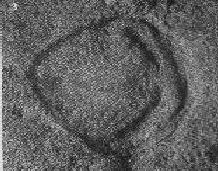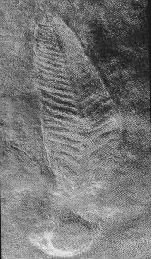© 2001 Ken Glasziou
© 2001 The Brotherhood of Man Library
There is no universally accepted definition of what constitutes life. However the vast majority of us accept that animals and plants are life forms, a large majority includes bacteria and fungi as life forms, while almost all think of viruses and disease-causing entities like prions as non-living. If we accept majority opinion, then “life” appears to have been present on our planet for something close to four billion years.
Perhaps the oldest evidence for life on our planet comes from the presence in ancient rock formations of complex structures termed stromatolites, structures that may be three meters high that are still being formed today. Stromatolites are found on many continents and in rocks dating back as far as almost four billion years. They are formed from a mat of what used to be called blue-green algae but have now been shown to belong to a simpler and more primitive group of prokaryote bacteria, the photosynthetic cyanobacteria.
Prokaryotes differ from eukaryotes in that they do not have their DNA isolated in chromosomes in a cell nucleus that undergoes division during cell replication. All of the multicellular organisms now found on our planet are eukaryotes.
The cyanobacteria are photosynthetic. They trap light from the sun using chlorophyll, and utilize the sun’s energy to split water into hydrogen and oxygen. The hydrogen is then combined with carbon dioxide gas of the atmosphere to generate the complex organic molecules necessary to form a living cell. Oxygen is a by-product of the process. Most of this oxygen finds its way into the atmosphere. Water plus living organisms are virtually the sole source of our atmospheric oxygen.


Unless cyanobacteria had their origin from some non-planetary source, they are far too complex to have been the first living organism on this planet. In fact they are so complex that, from a biochemical standpoint, it is virtually impossible to imagine how they could have come into being so soon after our 4.5 billion year old planet cooled sufficiently to allow for the possibility of life forms on its surface.
The eukaryotes are even more complex but had to wait for the time when sufficient oxygen had accumulated in the earth’s atmosphere from photosynthesis to permit their further development.
This oxygen level appears to have been reached more than two billion years ago. Evidence for the existence of these ancient prokaryotes and eukaryotes is found in fossilized form in many places—such as the Gunflint iron formation in the Huronian Basin of Southern Ontario. There, 30 different types having spheroidal, filamentous and sporelike forms have so far permitted classification of 16 different species from 14 genera. Both red and green algal fossils occur. The red algal species Eosphaera and Huroniospora fossils, both I.9 billion years old, bear close resemblance to the living genus Porphyridium.
The earliest evidence for the existence of the eukaryotes comes from 2.7 billion year old shales in West Australia in which hydrocarbon molecules called steranes have been found. These are produced exclusively by eukaryotic organisms.
The first fossils that unequivocally indicate the existence of more highly developed species are the crawling trails of sea-bottom-dwelling worm-like creatures, and are found among the Ediacaran fossils that occur as early as about one billion years ago—but disappear as the Cambrian explosion of life forms gained ground around 550 million years ago. Also found among the Ediacaran fossils are “dwelling tubes” composed mainly of calcium carbonate (lime) that were most probably secreted by sessile, filter feeding worm-like creatures.
The name Ediacaran comes from the discovery of the fossils of a group of strange, until then unknown, creatures in the Ediacaran mountain range in South Australia. The first discoveries came from rocks about 575 million years old and were of jelly-fish like creatures. Such fossil animals had never been found in rocks older than 550 million years—the beginning of the Cambrian period. Since that first discovery, other fossils classified with this group have been discovered on every continent except Antarctica and are dated as early as almost one billion years ago.
The mystery of these strange creatures deepened when Dr Mary Wade of Adelaide University unearthed a curious specimen which she was sure was a segmented animal. Named Spriggina after the geologist, Reginald Sprigg, who first discovered the Ediacarans, it was so primitive, yet so undeniably complex, that it appeared to be the missing link between the complex creatures of the Cambrian and the known single-celled creatures of the pre-Cambrian era.
Initially these Ediacarans were pronounced to be an entirely separate group of organisms and were given the name Vendobionts. However, the more that was learned about them, the more they came to be accepted as the probable ancestors of today’s animal kingdom. Though very primitive, some of these animals are now believed to have possessed muscles, internal organs, and head and tail regions.


How then do we account for The Urantia Book’s claim that the Life Carriers first brought life to this planet only 550 million years ago?
One possibility is that this was part of the revelators’ cosmology stated to be “not inspired” that may consist of a “universe frame” by which to aid our understanding of our place in the universe scheme of things. (UB 115:1.1)
Alternatively, it may be covered by the following statements: “The original life plasm of an evolutionary world must contain the full potential for all future developmental variations and for all subsequent evolutionary changes and modifications.” (UB 36:2.17)
“The material self, the ego-entity of human identity, is dependent during the physical life on the continuing function of the material life vehicle, on the continued existence of the unbalanced equilibrium of energies and intellect which, on Urantia, has been given the name life.” (UB 112:2.20)
It is quite possible that the genetic potential of cell forms prior to the beginning of the Cambrian period was quite incapable of eventually generating “intelligent” living organisms. And that only an organism having a genome with the potential of ultimately evolving to have “intellect” comes within the definition of what the Life Carriers understand as “life.”
If so, the probable function of the Life Carriers would have been to re-arrange existing genetic material so that, at some distant date, life having “intellect” would have a high probability of evolving. If this is true then the likelihood is that these Ediacaran organisms were the main source of the genetic material used to accomplish this task.